With the Galaxy S23, S23+ and S23 Ultra, Samsung is launching three new premium smartphones that, compared to their predecessors, have again improved in areas such as the camera and performance, but in some cases also have larger batteries offer and be produced more sustainably. Pre-order offers are intended to cushion higher prices at launch.
Table of contents
- Price, availability and pre-order promotion
- Pre-orderers get double storage
- Design and processing
- OLED displays with 6.1, 6.6 and 6.8 inches
- All screens are equally bright this time
- 200 MP camera for the Galaxy S23 Ultra
- 10x magnification with fourth camera
- Triple camera for the Galaxy S23 and S23+
- 8K video increased from 24 to 30 FPS
- Snapdragon 8 Gen 2 for Galaxy instead of Exynos
- Faster RAM and Storage
< /ol>
- Galaxy S23 and S23+ get larger batteries
- Samsung has the best software support
- Galaxy S23, S23+ and S23 Ultra specifications at a glance
Galaxy S23, S23+ and S23 Ultra are three new Android smartphones that are part of the growing area of premium and ultra-premium smartphones, as Samsung calls the growing segment. Despite the difficult situation on the market with inflation and rising living costs, the manufacturer is observing a trend in this direction and is therefore continuing to serve the area with three devices which – with the exception of special offers – have become even more expensive to buy this year, as already had been suspected in the run-up to the presentation.
Price, availability and pre-order campaign
The Galaxy S23 starts at 949 euros and thus costs 100 euros more than the Galaxy S22. The Galaxy S23+ and Galaxy S23 Ultra are each 150 euros more expensive, but the doubled memory of 256 instead of 128 GB compared to the predecessors must be taken into account, so that the surcharge is effectively lower. From now on, there is no longer any difference in color between the models, so that all variants are now available with all four new colors (Green, Lavender, Cream and Phantom Black), which are always matt. The manufacturer also sells the colors Graphite, Sky Blue, Red and Lime exclusively via its own online shop.
**Only in the Samsung online shop
Pre-orderers get double storage
Double the memory in the Galaxy S23+ and Galaxy S23 Ultra or not: prospective buyers will have to dig deeper into their pockets for a Galaxy S23 in the future. In order to cushion this situation somewhat, there is a promotion for pre-orders between February 1st immediately after today's presentation and the market launch on February 17th, during which an automatic upgrade to the larger memory configuration takes place, i.e. from 128 to 256 GB for example Galaxy S23. In addition, there will be a trade-in campaign starting with 150 euros for the old device and up to 700 euros depending on the model and condition of the traded smartphone. Other campaigns such as free in-ear headphones or smartwatches are not planned this time.
Design and processing
In terms of design, Samsung is again going two-pronged, so that the Galaxy S23 and Galaxy S23+ offer a completely flat front with a flat display and an aluminum frame running all around, while the Galaxy S23 Ultra again has a panel that is slightly curved towards the edges with a correspondingly adapted frame. According to customer feedback, the manufacturer has reduced the curvature again, which should optimize operation using the S Pen, which is located on the bottom left of the device. All three smartphones use Corning's new Gorilla Glass Victus 2 for the front and back, which is said to be repeatedly more resistant. Samsung is the first vendor in the world to use the new glass.
-
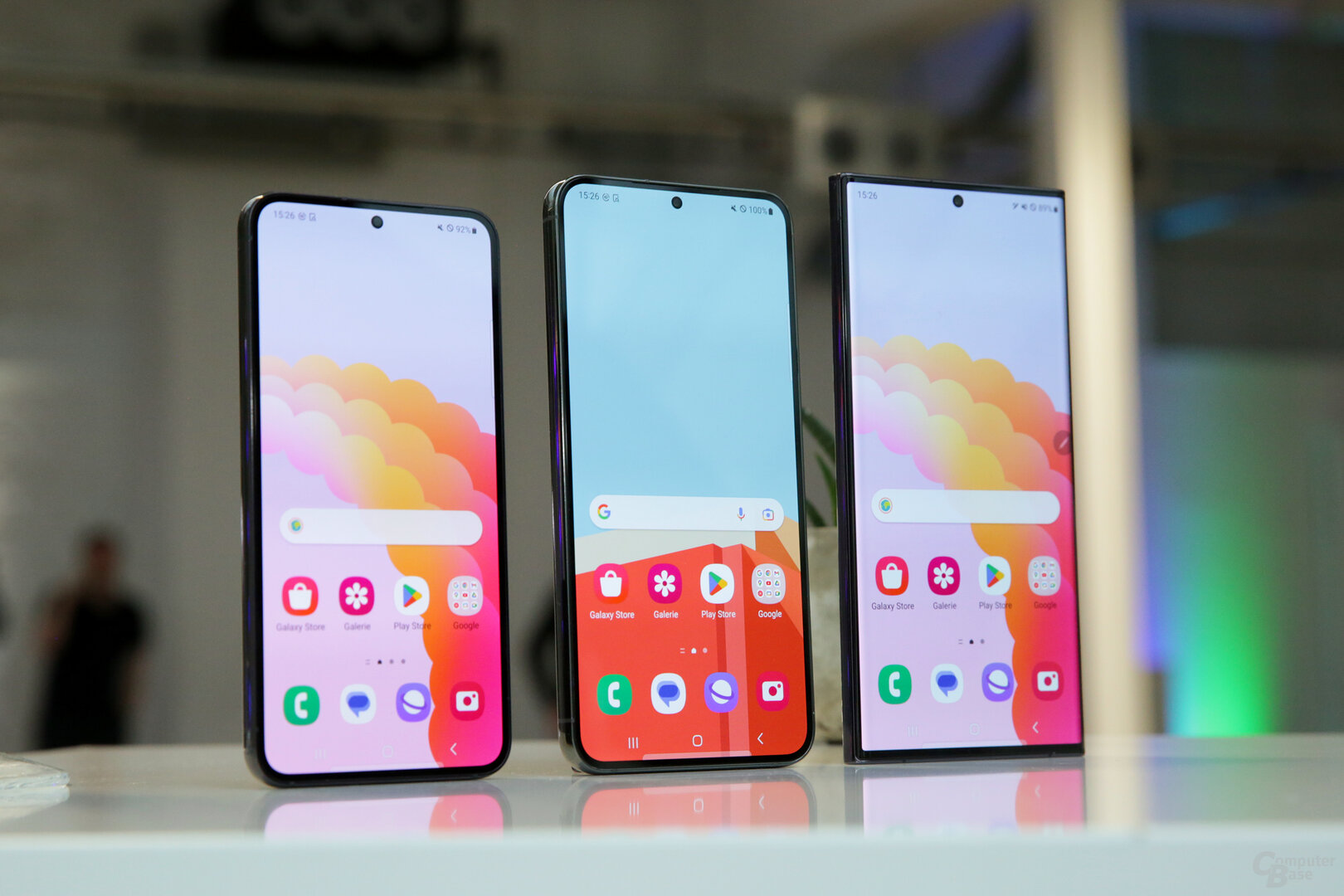 Samsung Galaxy S23, S23+ and Galaxy S23 Ultra
Samsung Galaxy S23, S23+ and Galaxy S23 Ultra
Image 1 of 7
 Matte colors and Gorilla Glass Victus 2 for all models
Matte colors and Gorilla Glass Victus 2 for all models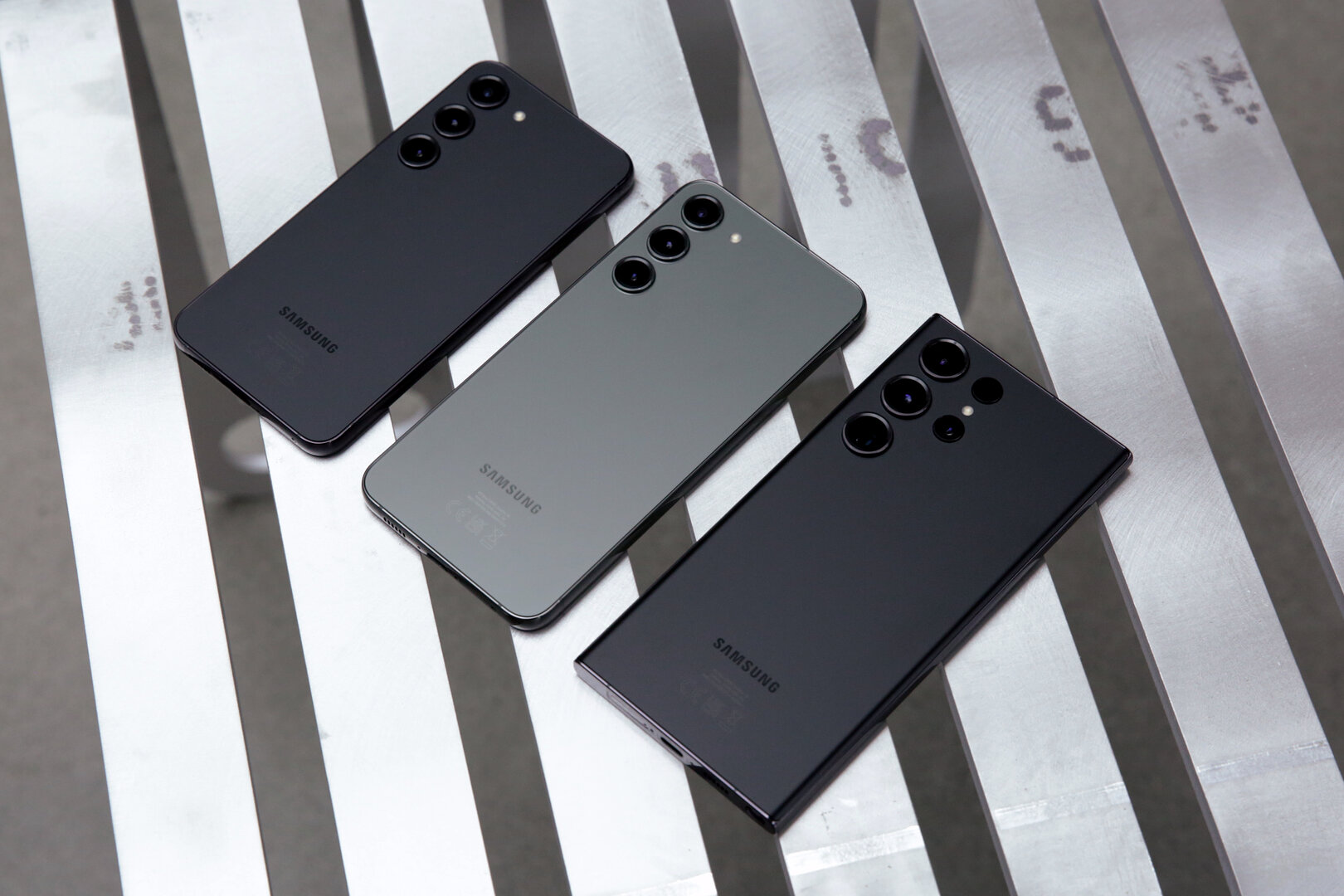 Galaxy S23, S23+ and S23 Ultra
Galaxy S23, S23+ and S23 Ultra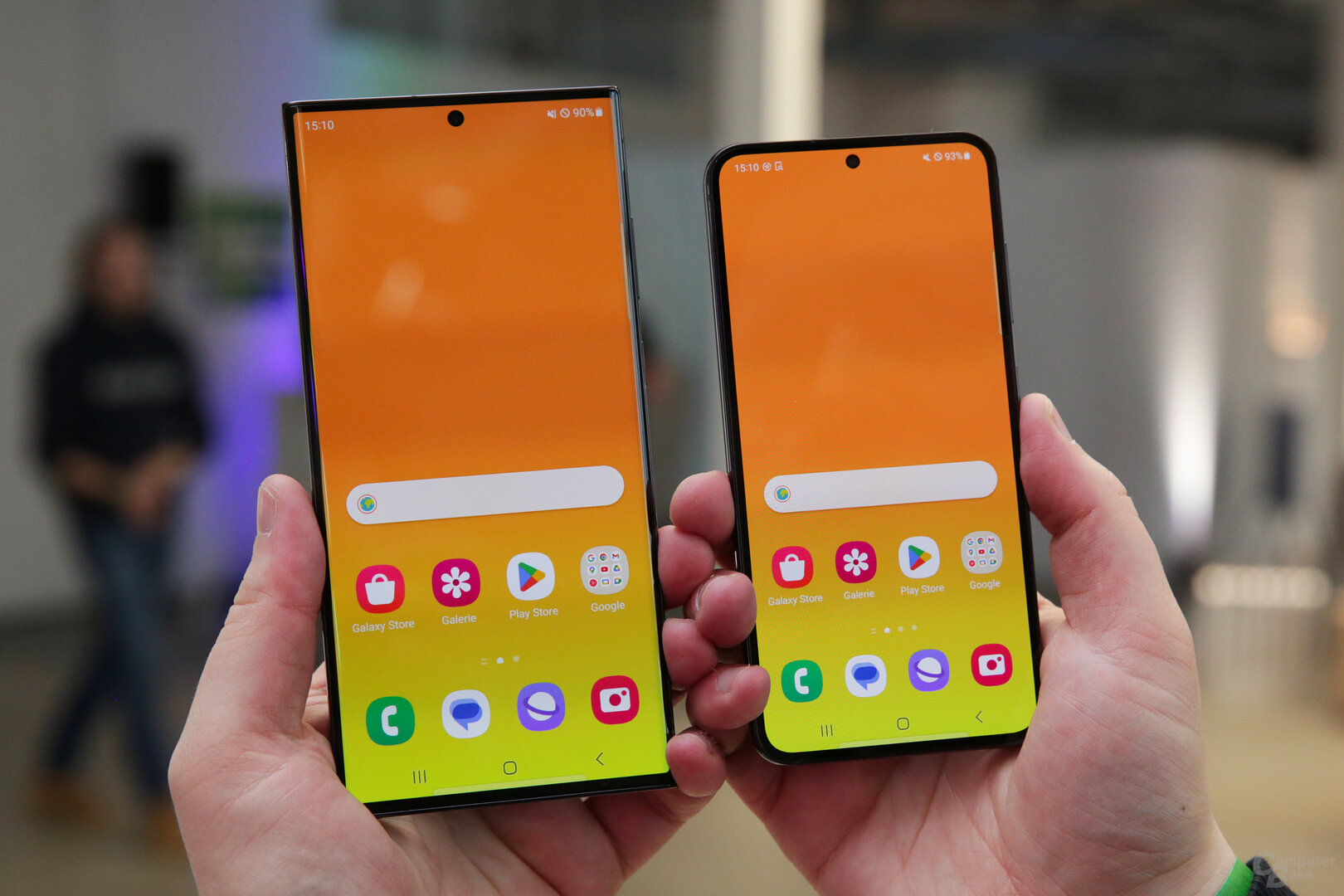 The biggest and the smallest Galaxy S23 compared
The biggest and the smallest Galaxy S23 compared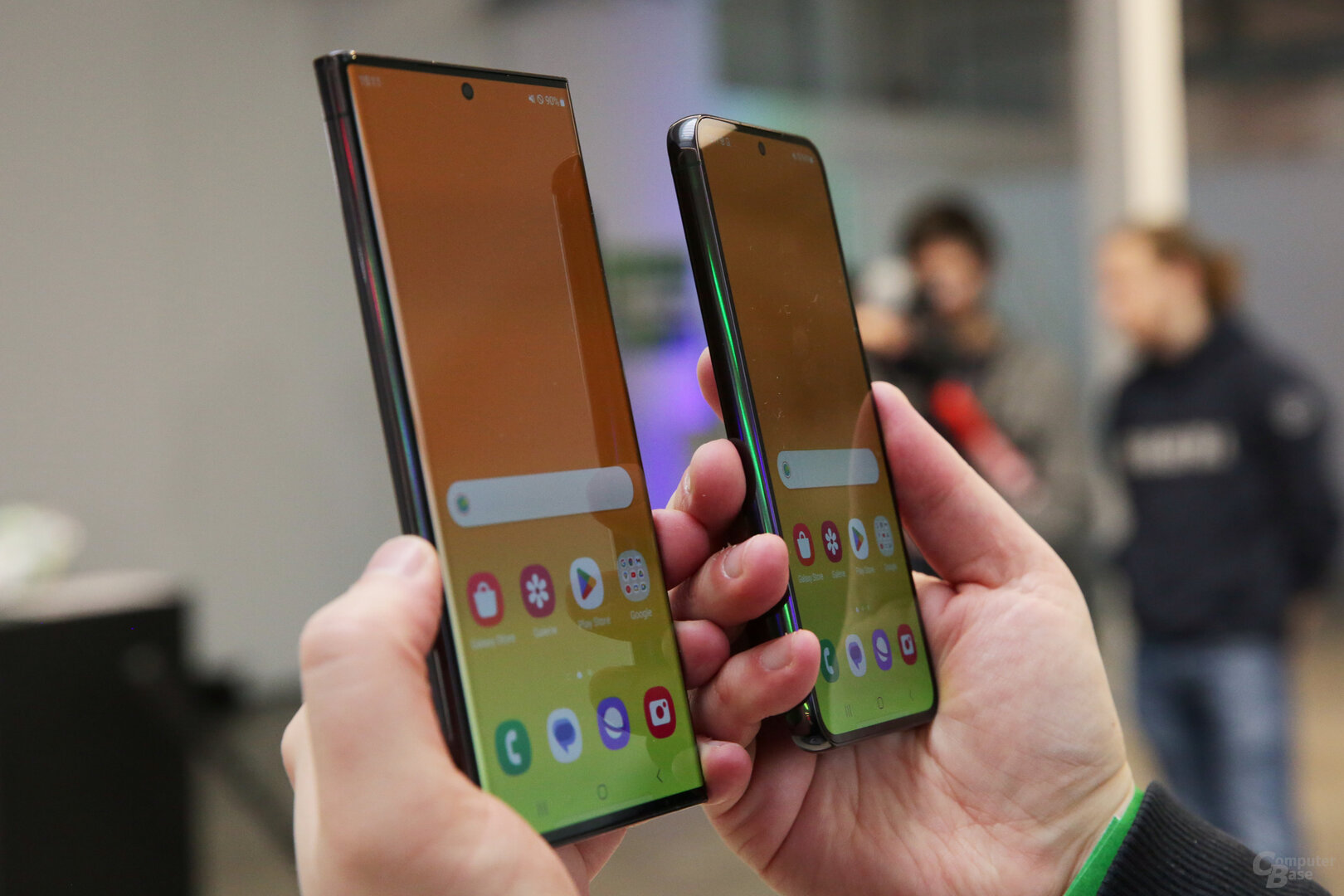 Rounded display on S23 Ultra, flat display on S23 and S23+
Rounded display on S23 Ultra, flat display on S23 and S23+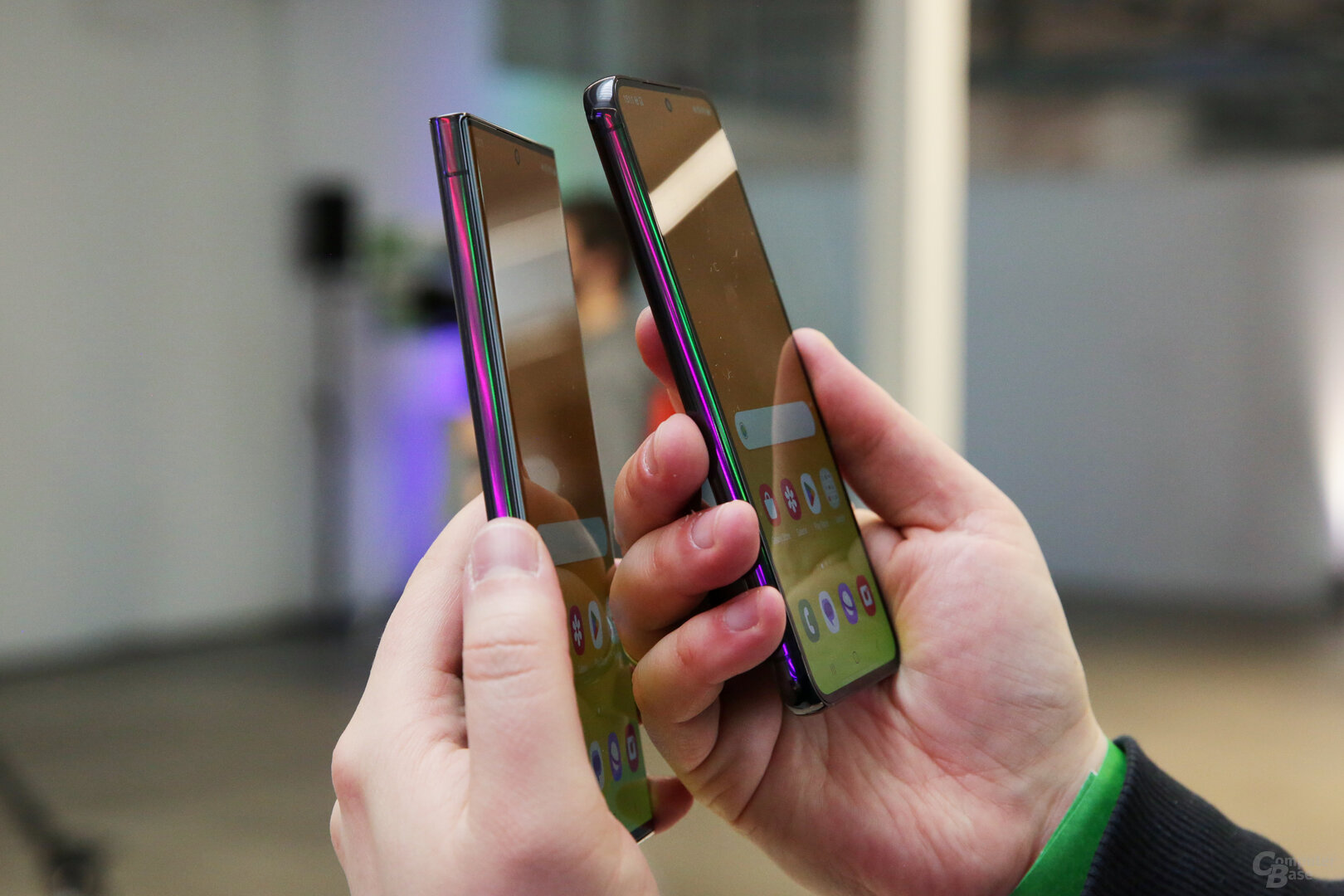 Rounded display on S23 Ultra, flat display on S23 and S23+
Rounded display on S23 Ultra, flat display on S23 and S23+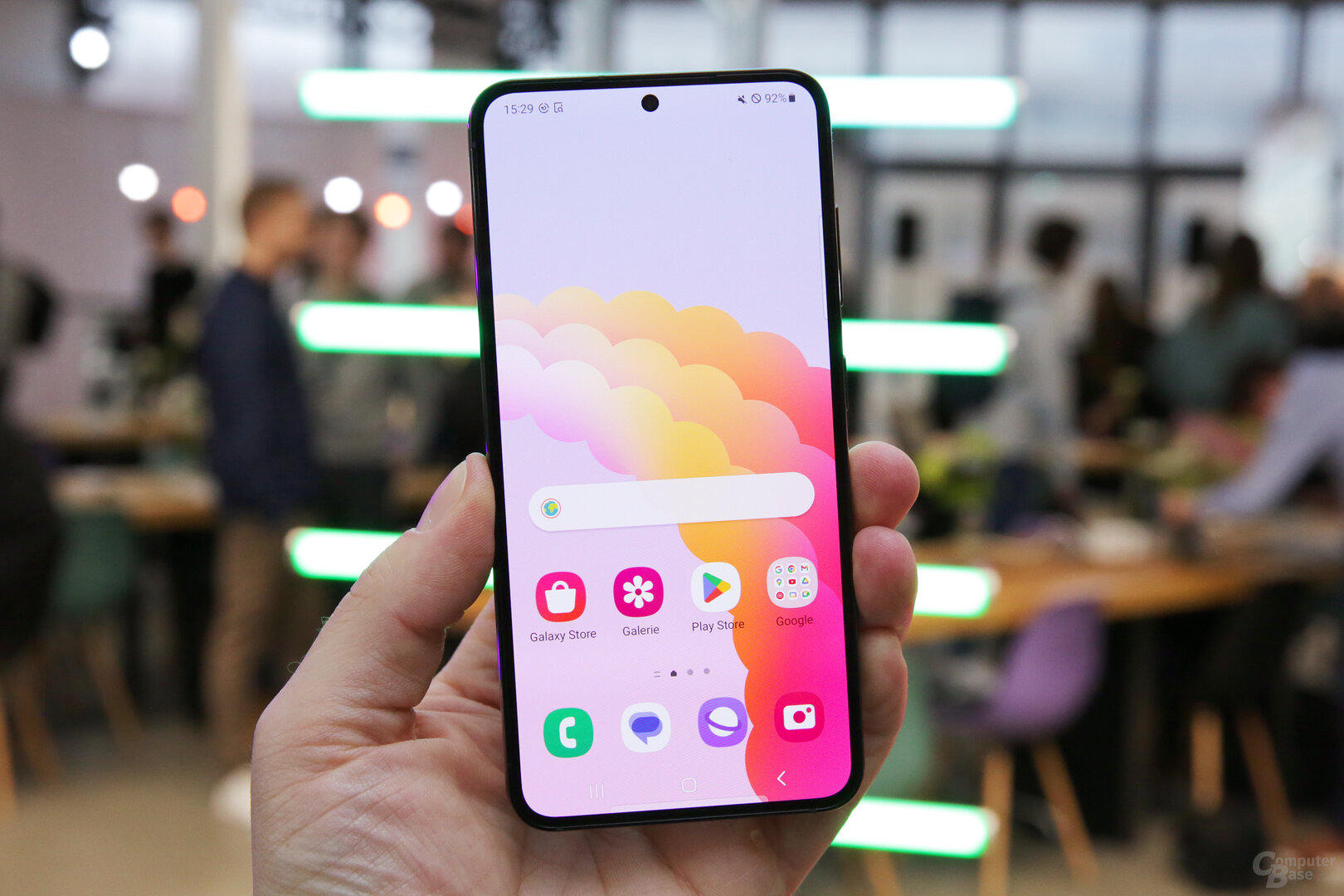 Galaxy S23 as a small flagship
Galaxy S23 as a small flagshipIt is not yet possible to make any statement about the durability, but after the first contact with the devices you can attest to a very high processing quality. The fact that more recycled materials are used in aluminum and plastic, for example, has no impact on the material quality. In terms of quality, the models correspond to what can be expected in view of the prices. Incidentally, the smartphones are again protected against the ingress of dust and water by an IP68 certification.
OLED displays with 6.1, 6.6 and 6.8 inches
The screen diagonals and the dimensions of the smartphones derived from them remain unchanged. In terms of decimal places, there are minor deviations from the Galaxy S22 series, but overall the devices are comparable in size to last year. The Galaxy S23 once again takes the position of a comparably compact flagship smartphone, as it was the best in the hand at 6.1 inches and 70.9 × 146.3 × 7.60 mm for the first hands-on. The Galaxy S23+ has a display of 6.6 inches and a total of 76.2 × 157.8 × 7.60 mm, while the Galaxy S23 Ultra is 6.8 inches with dimensions of 78.1 × 163.4 × 8.90 mm .
All screens are the same bright this time
Away from the diagonals, there are no longer any differences this year when it comes to the maximum radiance of the OLED displays. Samsung specifies a maximum brightness of 1,750 cd/m² for the entire series, which is a peak specification with a reduced white component. The editors will determine how the devices behave under which conditions for the later test. The OLED displays are again known as “AMOLED 2X” because they operate at up to 120 Hz at 240 Hz touch sampling rate. The Galaxy S23 and S23+ can vary from 48 to 120 Hz, the Galaxy S23 Ultra has the full spectrum from 1 to 120 Hz. Another distinguishing feature is the resolution of 1,080 × 2,340 pixels or 1,440 × 3,080 pixels, with the Galaxy S23 Ultra is driven with Full HD by default.
-
 The Galaxy S23 Ultra returns with S Pen
The Galaxy S23 Ultra returns with S Pen
Image 1 of 4
 The OLED displays measure 6.1, 6.6 and 6.8 inches
The OLED displays measure 6.1, 6.6 and 6.8 inches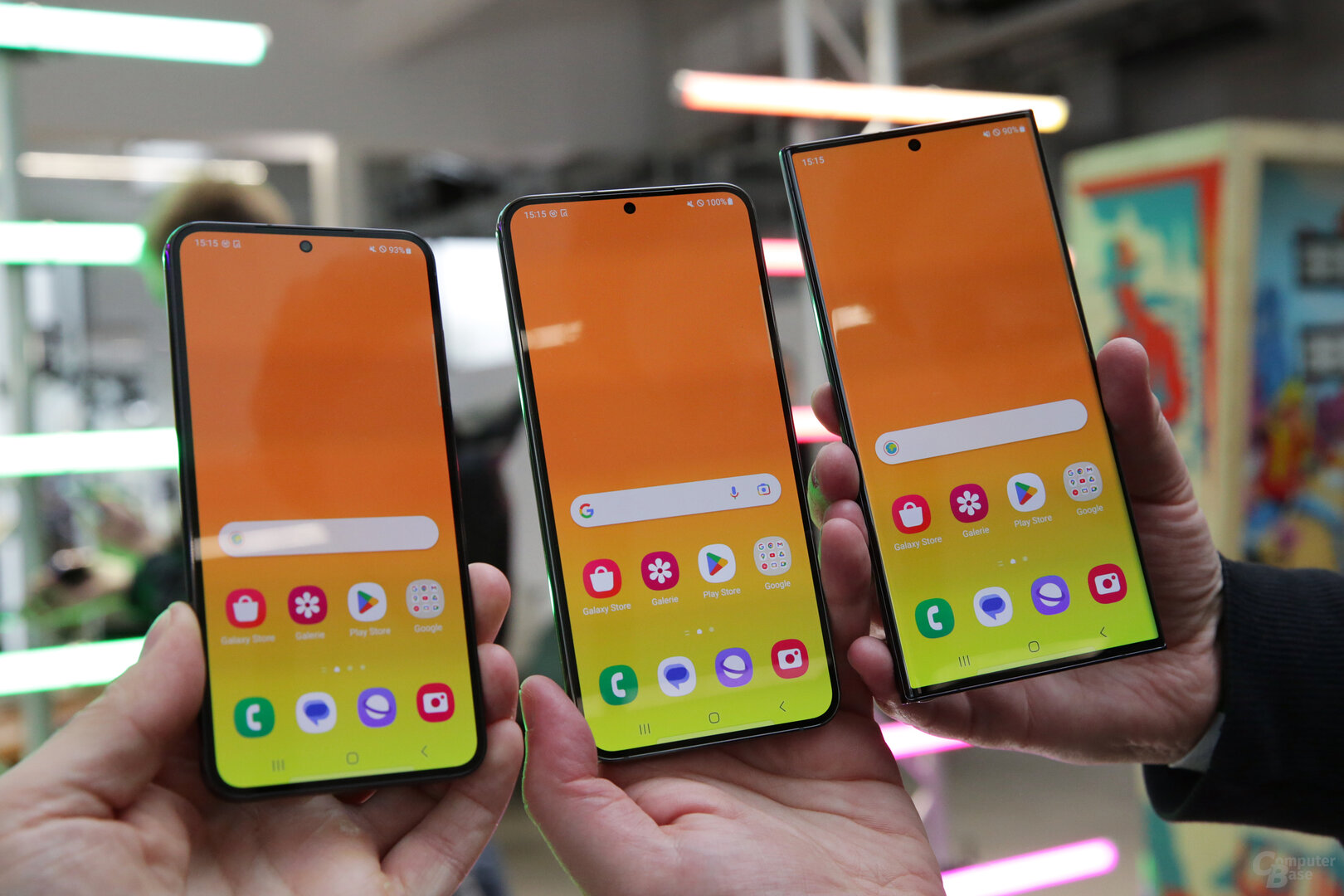 All screens should achieve up to 1,750 nits
All screens should achieve up to 1,750 nits200 MP camera for the Galaxy S23 Ultra
Galaxy S smartphones from Samsung always stand for the maximum in the camera area, with the Galaxy S23 Ultra occupying a special position with the most extensive equipment. In contrast to the smaller models and the direct predecessor, the resolution has increased from 50 MP or 108 MP to 200 MP through the use of the new ISOCELL HP2 sensor from our own production. The company only recently announced the new image sensor with 0.6 μm pixels on 1/1.3 inches. Despite the “smaller” name, the HP2 is intended to represent the new spearhead above the HP1 and HP3.
200 MP can also be called up natively, but usually there are images with 4 or 16 combined pixels for an image output in 50 MP or 12.5 MP, depending on the lighting conditions up to 1.2 or 2.4 μm in size get pixels. However, the sensor can use all 200 million pixels for phase comparison autofocus. For the first time, two transfer gates are used from the pixel to the logic layer of the sensor, which is intended to ensure more efficient signal transmission, reduce overexposure and improve color reproduction. According to Samsung, this feature is particularly relevant in bright light conditions.
Tenfold enlargement with fourth camera
The Galaxy S23 Ultra is the only one of the three new smartphones to have a fourth 10 MP camera with a so-called periscope zoom to enable a longer focal length in the thin chassis, which corresponds to a tenfold optical magnification compared to the primary lens. In the digital area, the image can also be zoomed up to 100x.
Triple camera for Galaxy S23 and S23+
< p class="p text-width">On the other hand, all three variants of the new series have a 10 MP camera with triple optical magnification. This third camera is used on the Galaxy S23 and S23+ alongside the 50 MP main camera and the 12 MP ultra wide-angle camera, which in turn is also offered by the Galaxy S23 Ultra. Speaking of 50 MP: This resolution can also be tapped in Expert RAW mode in order to have as much flexibility as possible for subsequent image processing. New for the Galaxy S23 and S23+ is the single bezel of the lenses on the back, after an additional frame was recently used there. All three smartphones now offer the same design on the back, with the exception of the number of lenses.
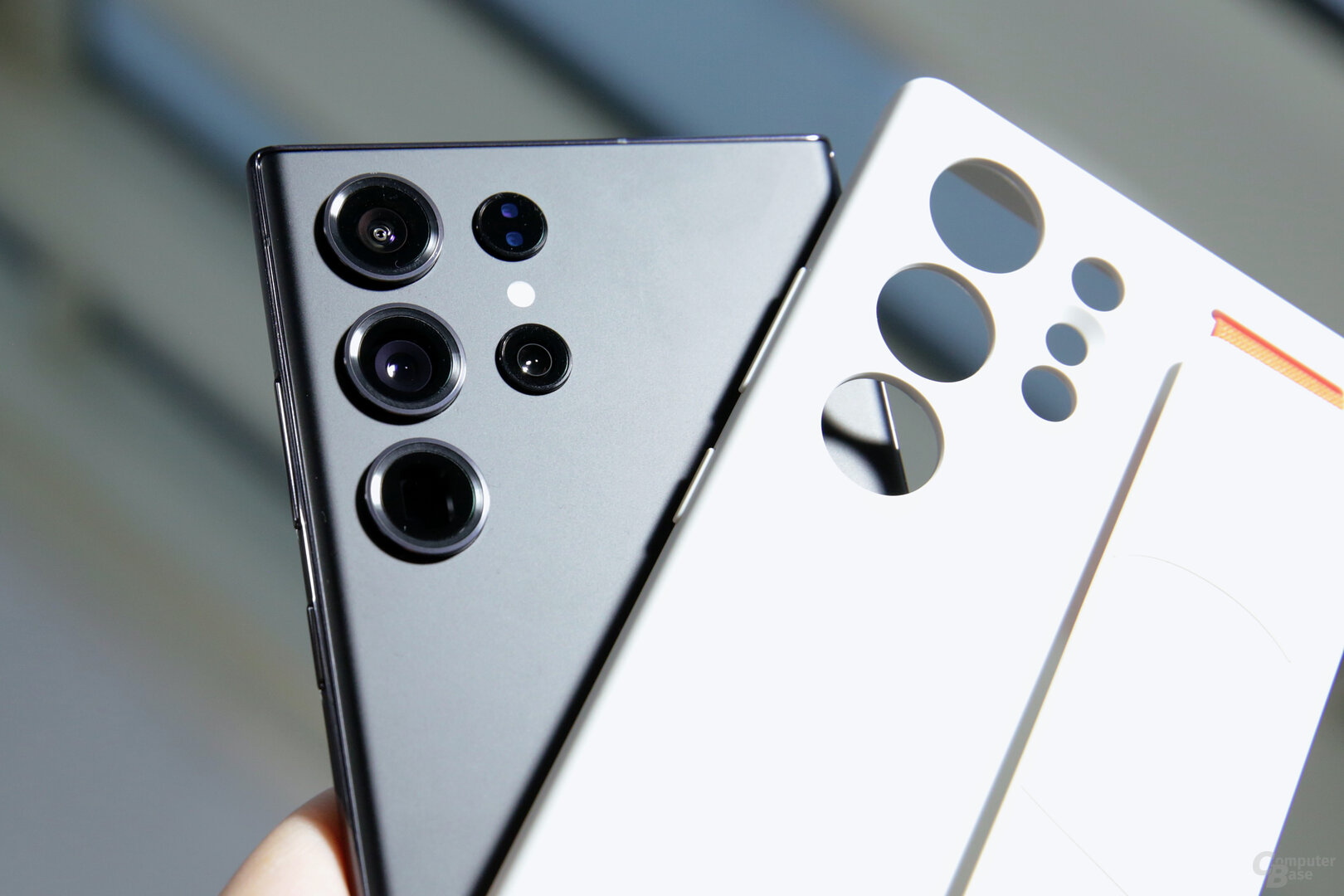 Only the Galaxy S23 Ultra comes with four cameras
Only the Galaxy S23 Ultra comes with four cameras8K -Video increased from 24 to 30 FPS
Cameras with at least 50 MP again enable video recording in 8K resolution, which requires at least 33 MP. While the refresh rate there was previously a maximum of 24 FPS, 30 FPS are now also possible. In HDR video mode, the smartphones support up to 4K at 60 FPS. The Galaxy S23 Ultra switches from 200 to 50 MP for 8K, i.e. combines four pixels into one, and then performs a crop on the sensor, which also gives room for electronic image stabilization. There is also an OIS on the primary lens and the telephoto lenses, with the Galaxy S23 Ultra now being able to compensate for deviations of 3 degrees instead of the previous 1.5 degrees.
Snapdragon 8 Gen 2 for Galaxy instead of Exynos
The sensors themselves also provide image improvements, but the processing in the image processor (ISP) also plays a role. Samsung speaks of optimizations in the areas of faces, eyes and hair, which are determined using AI and adjusted separately from the rest of the image in their own layers. The new series should also bring significant improvements in photo and video recordings at night and, for example, significantly reduce noise.
 Samsung now uses Qualcomm throughout
Samsung now uses Qualcomm throughoutQualcomm is responsible for the ISP this time, because this time Snapdragon processors are used throughout instead of their own Exynos processors. With the “Snapdragon 8 Gen 2 for Galaxy”, Samsung receives an exclusive version of the Snapdragon 8 Gen 2, which offers a 160 MHz increased peak clock of 3.36 GHz and a stronger GPU with 719 instead of 680 MHz for the prime core. The chip runs internally under the model number SM8550-AC instead of SM8550-AB and is reserved for Samsung for the time being. The changes are in line with what would normally have been expected from a “Snapdragon 8+ Gen 2”. It is not yet known whether other manufacturers will be able to obtain a more powerful version of the Snapdragon 8 Gen 2 (benchmark) at a later date. However, as by far the largest individual buyer of Qualcomm processors, Samsung initially has an exclusive position. The other key data of the chip correspond to those of the regular variant.
Faster RAM and memory
With the Snapdragon 8 Gen 2 comes adjustments in RAM and storage, now moving to faster LPDDR5X and UFS 4.0. The Galaxy S23 and S23+ always offer 8 GB of RAM, while the Galaxy S23 Ultra is also available with 12 GB of RAM. When it comes to storage, it should be noted that although this largely corresponds to UFS 4.0, the smallest basic model in the Galaxy S23 with 128 GB still uses UFS 3.1. In practice, the differences in the actual operating feel should be small, but the sequential transfer rates will not come close to UFS 4.0. With UFS 4.0, the throughput is doubled again: 23.2 Gbit/s or 2,900 MB/s are transmitted per line. As with the predecessor, two lines can also be used, the maximum data throughput increases to 46.4 Gbit/s or 5,800 MB/s. However, the user data rate is lower.
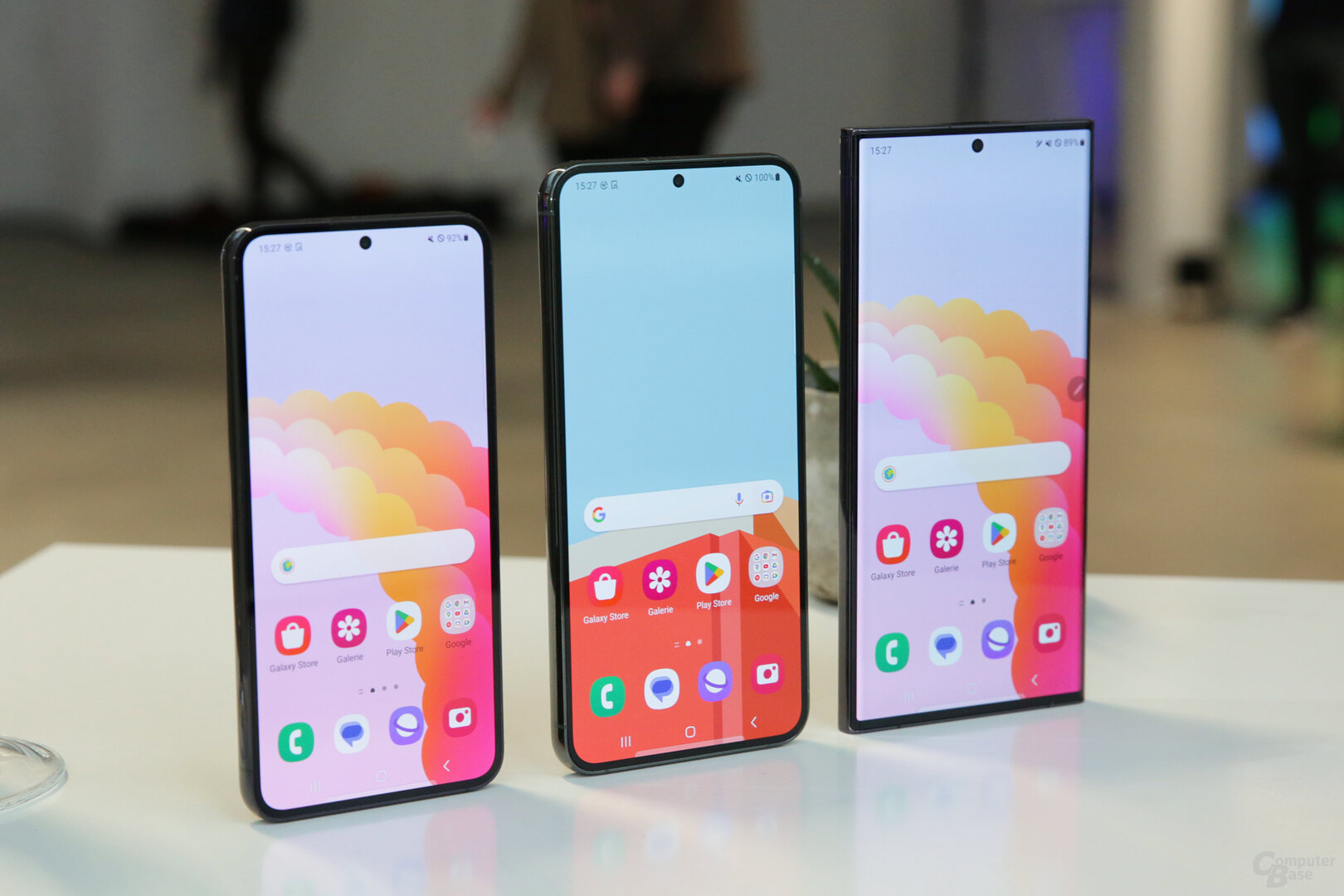 Samsung Galaxy S23, S23+ and Galaxy S23 Ultra
Samsung Galaxy S23, S23+ and Galaxy S23 UltraGalaxy S23 and S23+ get bigger batteries
Buyers of the two smaller smartphones will get 200 mAh more compared to the same Galaxy S22 models with battery capacities of 3,900 mAh and 4,700 mAh, while the Galaxy S23 Ultra stays at the familiar 5,000 mAh. When it comes to the charging speed, Samsung continues to be rather conservative compared to Chinese providers and leaves it at 25 watts for the Galaxy S23 and S23+ and 45 watts for the Galaxy S23 Ultra. With Samsung, on the other hand, all three variants can be charged wirelessly.
Samsung has the best software support
Galaxy S23, S23+ and S23 Ultra come with Android 13 and a slightly updated One UI 5.1. The manufacturer promises the smartphones at least four main Android versions up to Android 17 and five years of monthly security updates. Samsung offers the best support in the Android environment, even ahead of Google.
Overview of the specifications of the Galaxy S23, S23+ and S23 Ultra
Samsung Galaxy S23 Samsung Galaxy S20Samsung Galaxy S20 5GSamsung Galaxy S20 FESamsung Galaxy S20 Ultra 5GSamsung Galaxy S20+Samsung Galaxy S20+ 5GSamsung Galaxy S21Samsung Galaxy S21 FESamsung Galaxy S21 UltraSamsung Galaxy S21+Samsung Galaxy S22Samsung Galaxy S22 UltraSamsung Galaxy S22+Samsung Galaxy S3 Ultra ✔Samsung Galaxy S23+ ✔ Samsung Galaxy S23+ Samsung Galaxy S20Samsung Galaxy S20 5GSamsung Galaxy S20 FESamsung Galaxy S20 Ultra 5GSamsung Galaxy S20+Samsung Galaxy S20+ 5GSamsung Galaxy S21Samsung Galaxy S21 FESamsung Galaxy S21 UltraSamsung Galaxy S21+Samsung Ultrasung2Samsung Galaxy S22Samsung Galaxy Galaxy S23 ✔Samsung Galaxy S23 Ultra ✔Samsung Galaxy S23+ ✔ Samsung Galaxy S23 Ultra Samsung Galaxy S20Samsung Galaxy S20 5GSamsung Galaxy S20 FESamsung Galaxy S20 Ultra 5GSamsung Galaxy S20+Samsung Galaxy S20+ 5GSamsung Galaxy S21Samsung Galaxy S21 FESamsung Galaxy S21Samsung Galaxy S21Samsung2Samsung Galaxy S2+Samsung Galaxy Galaxy S22 UltraSamsun g Galaxy S22+Samsung Galaxy S23 ✔Samsung Galaxy S23 Ultra ✔Samsung Galaxy S23+ ✔ Software:(on release) Android 13.0 Display: 6.10″, 1080 × 2340
422 ppi, 120 Hz
Dynamic AMOLED 2X, HDR, Gorilla Glass Victus 2 6.60″, 1080 × 2340
390 ppi, 120 Hz
Dynamic AMOLED 2X, HDR, Gorilla Glass Victus 2 6.80″, 1440 × 3080
500 ppi, 120 Hz
Dynamic AMOLED 2X, HDR, Gorilla Glass Victus 2 Operation: touch, fingerprint sensor, face scanner Touch, stylus, fingerprint sensor, face scanner SoC: Qualcomm Snapdragon 8 Gen 2
1 × Cortex-X3, 3, 36GHz
2× Cortex-A715, 2.80GHz
2× Cortex-A710, 2.80GHz
3× Cortex-A510R, 2.00GHz
4nm, 64-bit GPU: Adreno 740
719MHz RAM: 8,192MB
LPDDR5X 8,192 MB
LPDDR5X variant12,288 MB
LPDDR5X Storage: 128/256 GB 256/512 GB 256/512/1,024 GB 1. Camera: 50.0 MP, 4320p
LED, f/1.8 , AF, OIS 200.0 MP, 4320p
LED, f/1.7, AF, OIS 2nd camera: 12.0 MP, f/2.2 3rd camera: 10.0 MP, f/2 .4, AF, OIS 4. Camera: No 10.0 MP, f/4.9, AF, OIS 5. Camera: No 1. Front camera: 12.0 MP, 2160p
Display flash, f/2 ,2, AF 2. Front camera: No GSM: GPRS + EDGE UMTS: HSPA+
↓42.2 ↑5.76 Mbit/s LTE: Advanced Pro 5G: NSA/SA WLAN: 802.11 a/b/g/n /ac/ax
Wi-Fi Direct Bluetooth: 5.3 Location: A-GPS, GLONASS, BeiDou, Galileo, QZSS, NavIC Other standards: USB 3.2 Type C, NFC USB 3.2 Type C, UWB, NFC SIM card: Nano SIM, Dual SIM Battery: 3,900 mAh, 25.0 W
permanently installed, wireless charging 4,700 mAh, 25.0 W
permanently installed, wireless charging 5,000 mAh, 45.0 W
permanently installed, wireless charging Size (B ×H×D): 70.9 × 146.3 × 7.60 mm 76.2 × 157.8 × 7.60 mm 78.1 × 163.4 × 8.90 mm Degree of protection: IP68 Weight: 167 g 195 g 233 g Price: 949 €/1,009 € 1,199 €/1,319 € 1,399 €/1,579 €/1,819 €
ComputerBase has information about this article from Samsung at an event held by the manufacturer in Berlin received under NDA. The only requirement was the earliest possible publication date.
This article was interesting, helpful or both? The editors appreciate any support from ComputerBase Pro and disabled ad blockers. More about ads on ComputerBase.